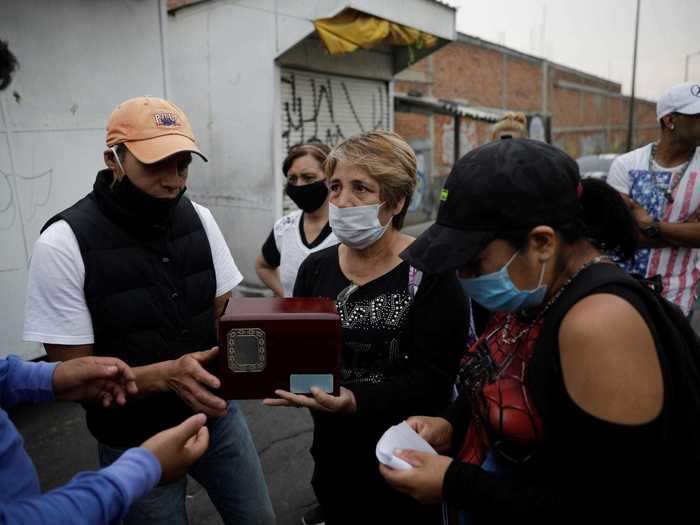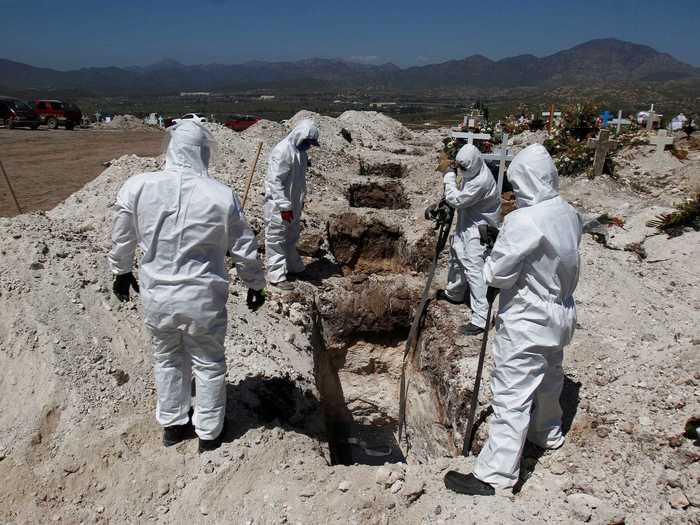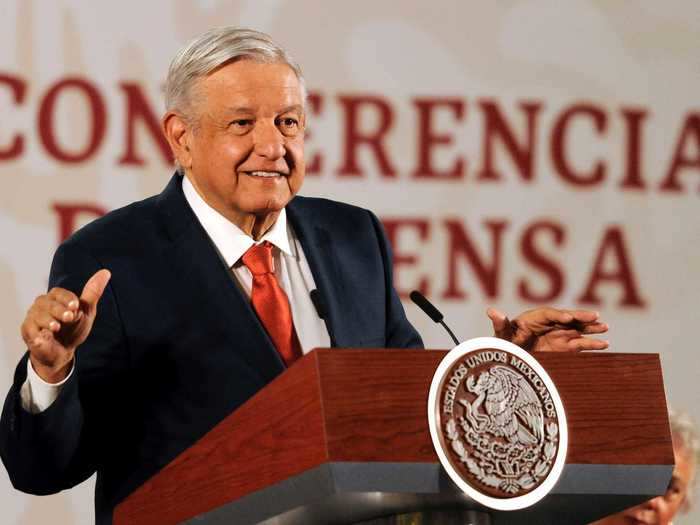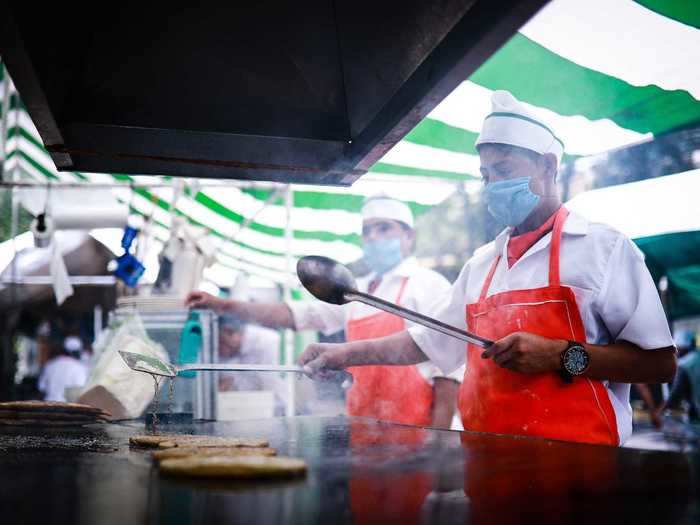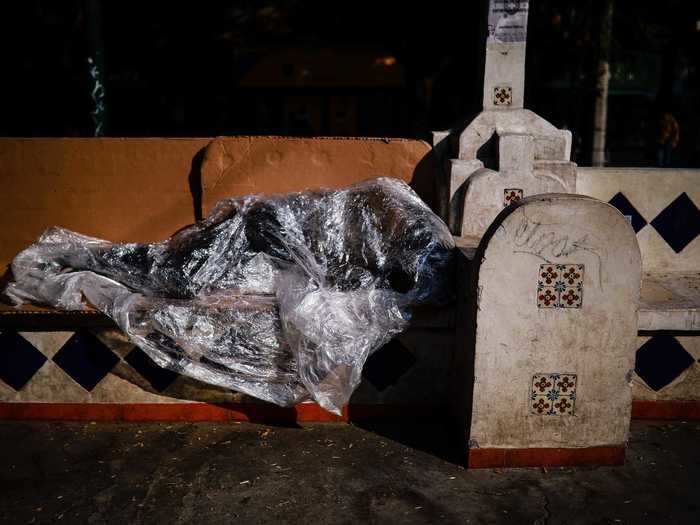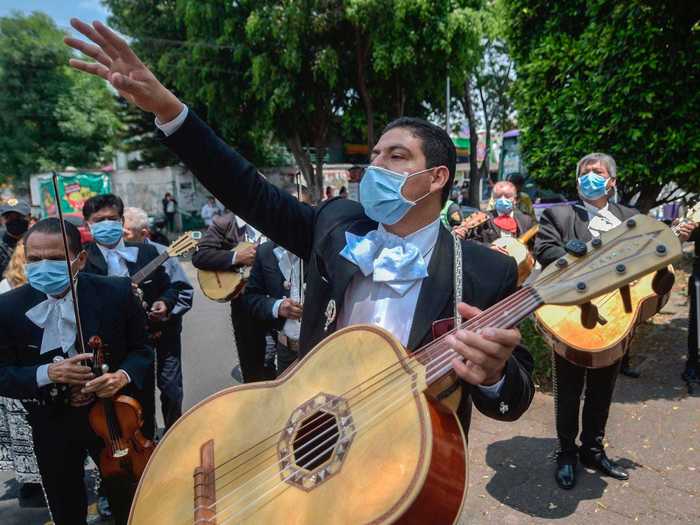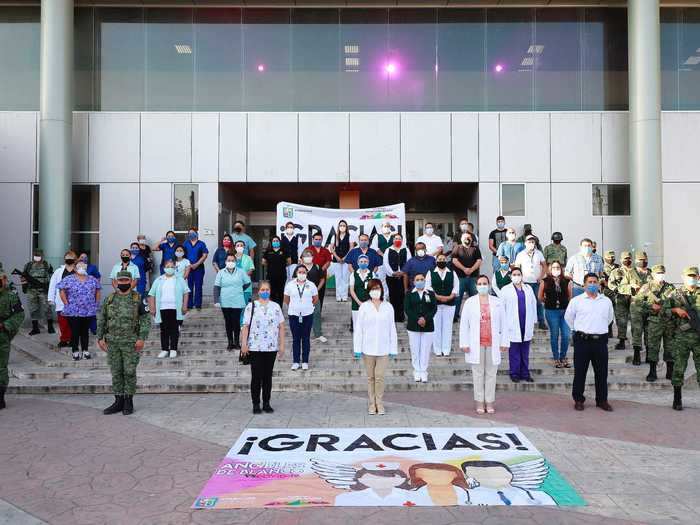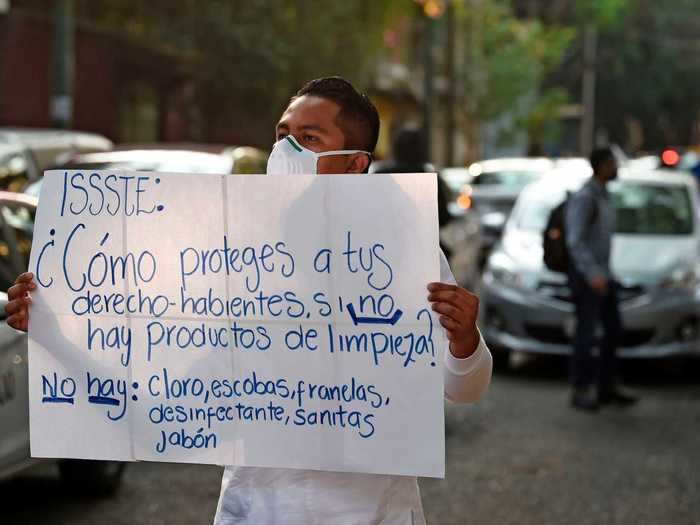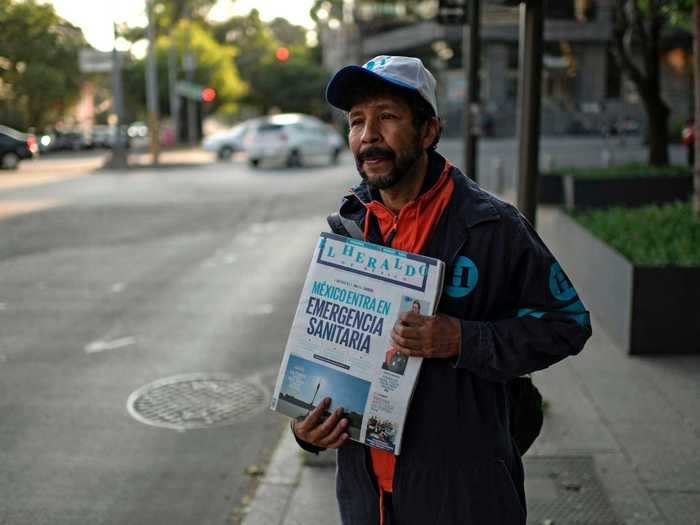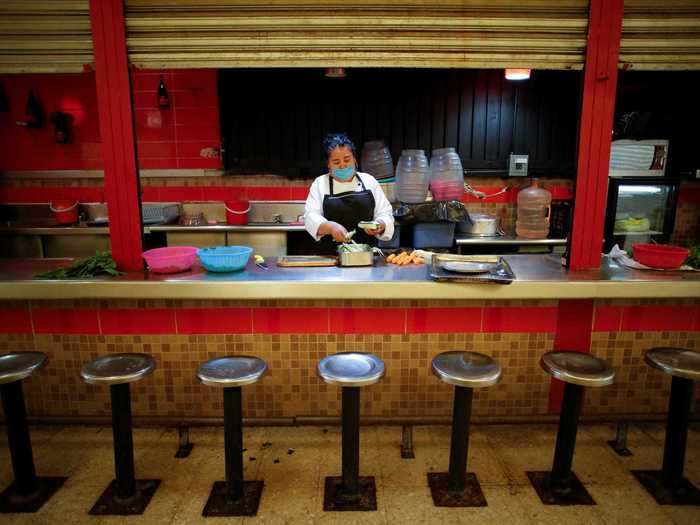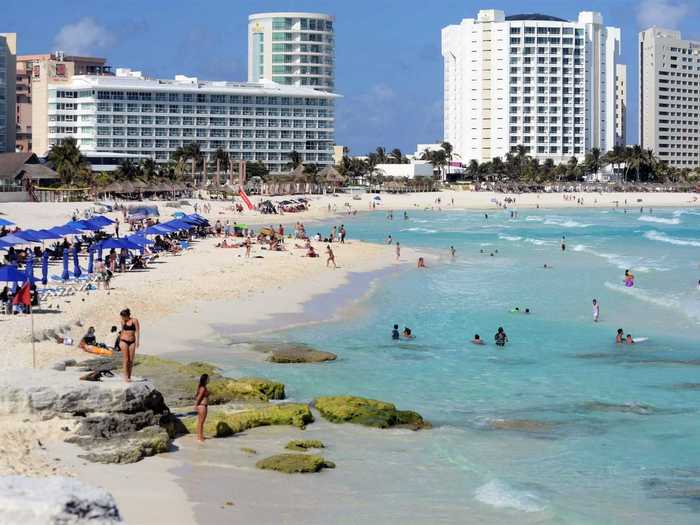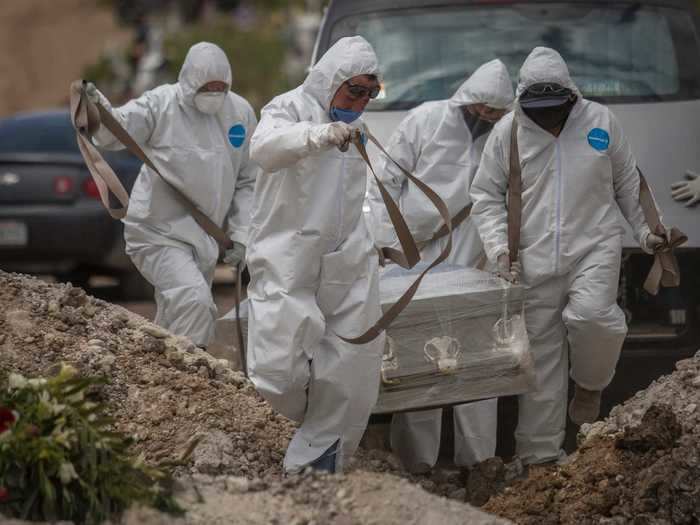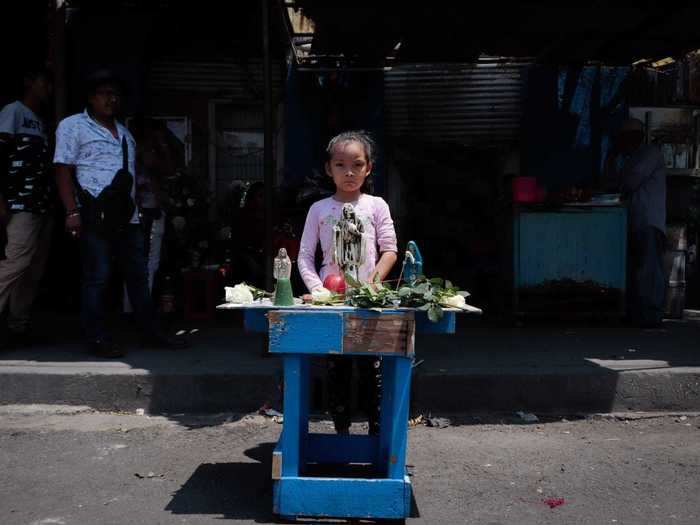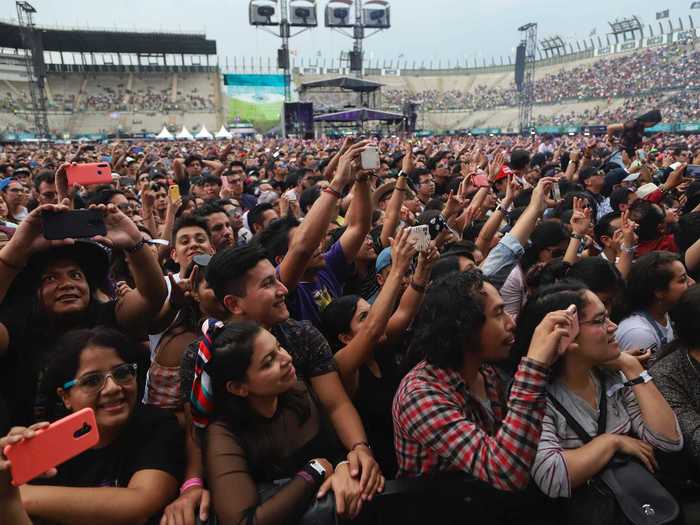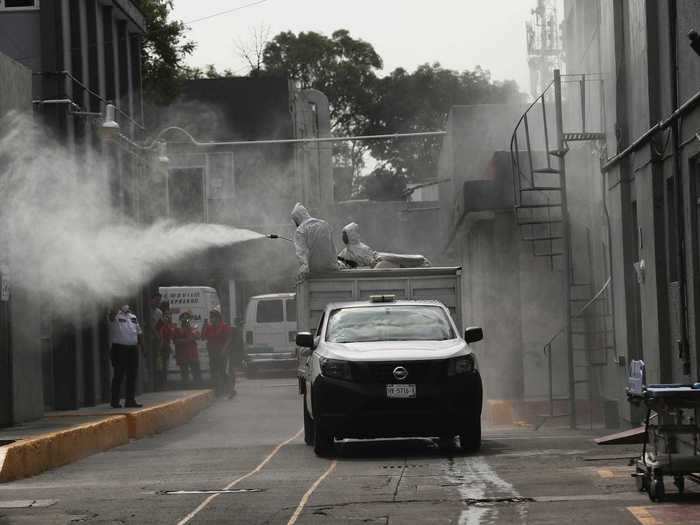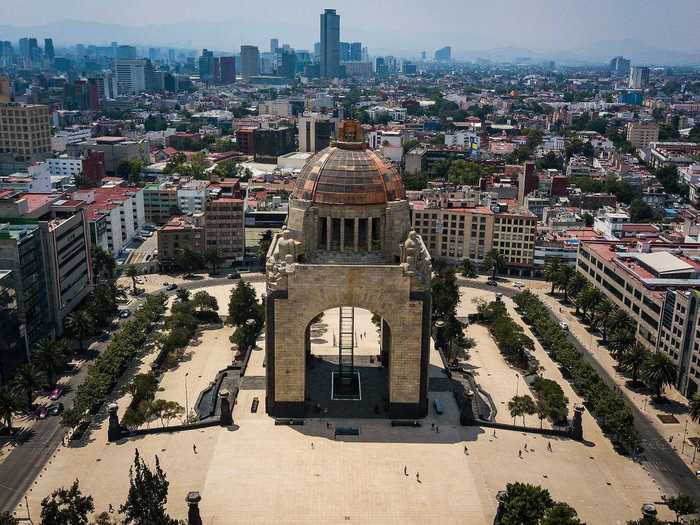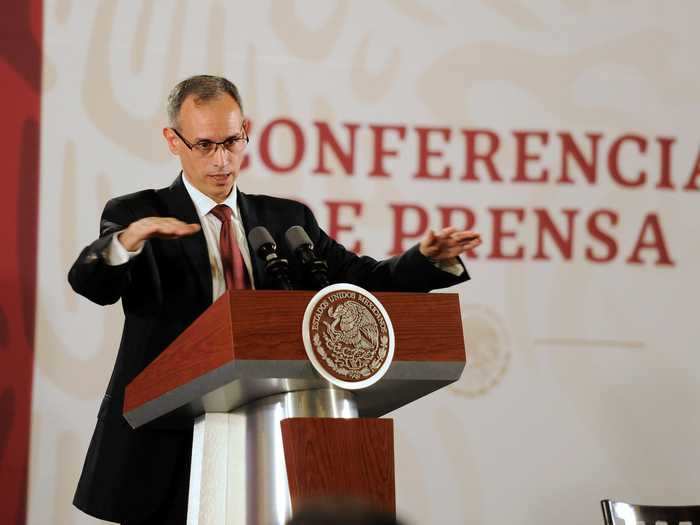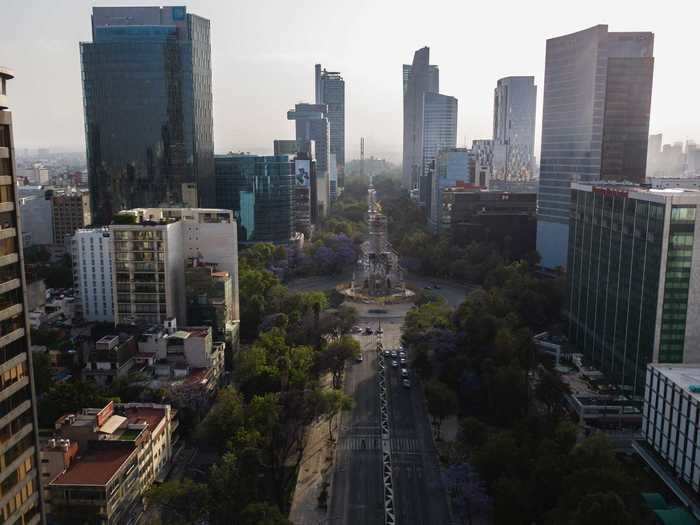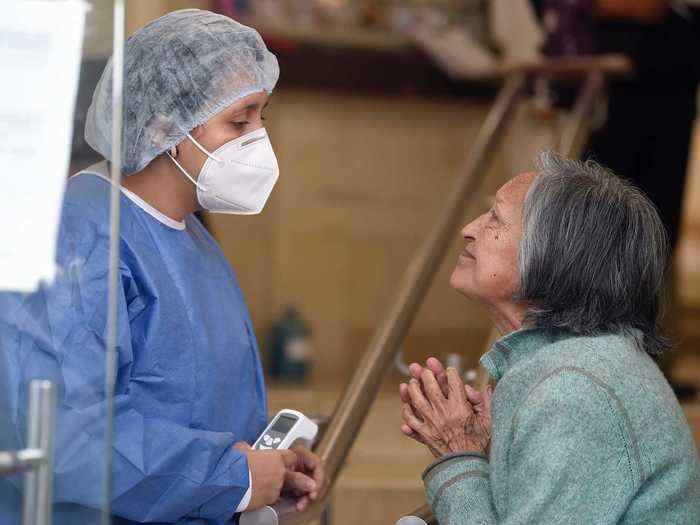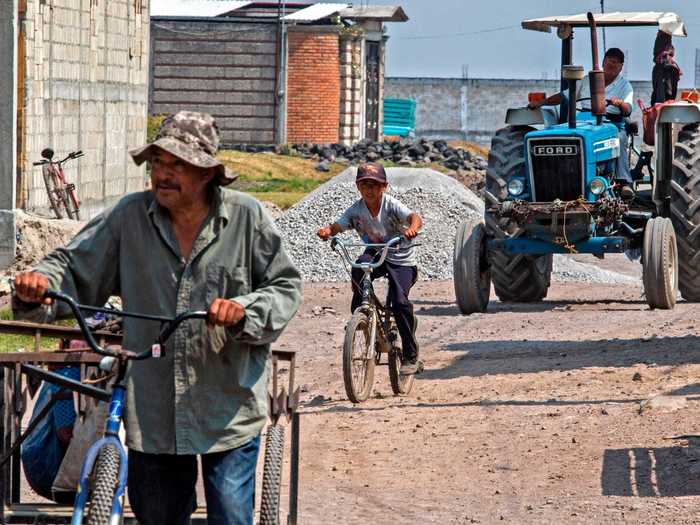Family members hold an urn containing the remains of Lucia Escobar Paredes, 75, who died of the COVID-19 outside of Izaz crematorium, in Mexico City on April 22.Luis Cortes / Reuters
- Mexico, a nation of 120 million, with about half of that living in poverty, and 60 percent relying on unregistered businesses, is preparing for a spike in coronavirus cases.
- On Tuesday, the government moved the country to "Phase Three," the most serious stage of the pandemic, when the coronavirus is meant to accelerate through the country.
- As of April 23, it had 10,554 confirmed cases with 970 deaths, according to data from Johns Hopkins University. But Reuters reported that the government estimated there were about 55,951 cases across the country.
- As Mexico entered stage three, President Andrés Manuel López Obrador said: "I want to give a guarantee... that we Mexicans are going to be able to overcome this crisis. We are going to win together."
- Visit Insider's homepage for more stories
Mexican President Andrés Manuel López Obrador, who faced criticism early on in the pandemic for hugging and kissing his fans instead of social distancing, told reporters on Tuesday: "We are prepared to confront the most difficult moment."
He said this as the nation of 120 million people entered "Phase Three," its most serious level for dealing with the coronavirus. Phase one was beginning to prepare, phase two was putting in safety measures, like banning nonessential activities. Phase three is when the coronavirus accelerates through the country, according to the Los Angeles Times.
As of April 23, it had 10,554 confirmed cases of COVID-19 with 970 deaths, according to data from Johns Hopkins University. But Reuters reported on Thursday that a government's mathematical model estimated there were 55,951 cases across the country.
Mexico has been handling the coronavirus differently from much of the world. Along with the president defending hugging, Hugo López-Gatell, the man who's leading Mexico's coronavirus response, said as recently as April 17, he still wasn't sure how bad the coronavirus really is.
Mexico's economy has been a major factor, leading authorities to keep its borders open, and refusing to enforce a national lockdown. Mexico has also done little testing compared with other nations. As of March 31, it tested 65 people per million inhabitants, compared to the US which has tested 2,250 people per million, according to The Washington Post.
Here's how Mexico got to the point is it at now and what could come next.
Read the original article on
Insider
On April 23, there were 1,000 new confirmed cases in a single day. Even so, Obrador refused to say he would act against those who broke coronavirus guidelines. As Mexico's cases continued to rapidly rise, he said: "Everything is done through persuasion."
Family members hold an urn containing the remains of Lucia Escobar Paredes, 75, who died of the COVID-19 outside of Izaz crematorium, in Mexico City on April 22.
Luis Cortes / Reuters
The following day Mexico confirmed it had 10,000 cases. It had taken only nine days for the cases to double from 5,000.
Cemetery workers wearing protective suits lower the coffin of a coronavirus victim in a pit at the municipal cemetery, amid the spread of the coronavirus disease, in Tijuana, Mexico on April 22.
Jorge Duenes / Reuters
On April 21, Mexico declared it was entering "Phase Three." Obrador, who had not taken the pandemic seriously for weeks, said: "I want to give a guarantee ... that we Mexicans are going to be able to overcome this crisis. We are going to win together."
Andres Manuel Lopez Obrador President of Mexico, speaks at the National Palace on March 25 in Mexico City.
Pedro Gonzalez Castillo/Getty
He said: "I'll repeat: 0.5% of the population will have some kind of symptoms out of the total Mexican population. [The great majority] will develop immunity without ever knowing they were infected." But according to other experts the Wall Street Journal spoke to, he was being unrealistic.
Julio prepares a "gordita de chicharron" in the Antojitos Mexicanos stand at Ometusco street on April 17 in Mexico City.
Manuel Velasquez/Getty
On April 17, when Mexico's cases had leaped up to 6,875 with 546 deaths, López-Gatell told the Wall Street Journal he still wasn't sure how bad the coronavirus was and compared it to the common flu. He said: "I don't know yet. The WHO says it could be 10 times that of influenza, but I think we need to see more evidence."
A homeless man cover with a plastic sleeps in a bench of the Condesa neighborhood on April 16 in Mexico City.
Manuel Velasquez/Getty
Some showed their support however they could. On April 7, this mariachi band wearing masks played for the National Institute of Respiratory Diseases in Mexico City, to give hope to those fighting COVID-19 and the healthcare workers.
A mariachi band serenades the National Institute of Respiratory Diseases (INER) in Mexico City, on April 7 to give hope to those fighting COVID-19 and the medical personnel during the coronavirus pandemic.
Pedro Pardo / AFP / Getty
But, according to The Washington Post, even before the man's death doctors and nurses at the hospital where he died held demonstrations to protest their lack of protective gear. One nurse told a television network: "There's no material, no equipment — gloves, masks, there's never any of that."
Medical staff pose during a recognition for their work at a Mexican hospital on April 20.
Medios y Media/Getty
In early April, the weaknesses in Mexico's health-system became apparent. Unrest and calls for more protective equipment came after a 42-year-old man died of COVID-19, after being treated in a hospital without being isolated. His treatment led to 41 employees getting the virus.
A health worker holds a sign reading: "How do you protect rights-holders if there are no cleaning products?" during a demonstration in Mexico City on April 21.
Alfredo Estrella / AFP / Getty
On March 31, Mexico declared a "health emergency," with 1,000 confirmed cases of COVID-19. Adding to its problems, Mexico was also dealing with the worst month of homicides since records began in 1997 — in March, 2,585 people were killed.
A newsboy holds a newspaper which headline reads Mexico enters health emergency at Polanco neighborhood in Mexico City on March 31.
Pedro Pardo / AFP / Getty
By the end of the month, Mexico's lack of testing was apparent. In contrast to South Korea's mass testing and intense tracking practices, the government did not even try to test all potential cases.
A member of the Monterrey´s health system performs a coronavirus test on a woman on April 9 in Monterrey.
Medios y Media/Getty
As of March 31, it had tested 65 people per million inhabitants, compared to the US which had tested 2,250 people per million, according to The Washington Post.
Source: Washington Post
Still, public markets and other establishments remained open. On March 26, Mexico had 475 confirmed cases of COVID-19 and six deaths.
A woman prepares food at her stall at a market amid the spread of the coronavirus disease, in Mexico City, in April.
Gustavo Graf / Reuters
On March 24, the government declared "Phase Two," which meant the coronavirus was spreading unchecked in communities. The government ordered nonessential businesses to close, banned large gatherings, and enforced social distancing.
A woman boards a public bus in Mexico City in April.
Alfredo Estrella / AFP / Getty
Five days later, on March 23, popular tourist destinations were still busy, like this beach in Cancun.
'Playa Gaviota Azul' also known as 'Playa Forum' recorded almost normal tourist activity, on March 23 in Cancún, Mexico.
Medios y Media/Getty
On March 18, Mexico reported its first death from COVID-19.
Workers in protective suits carrying a coffin in a cemetery during the Covid 19 pandemic in Mexico.
Omar Martínez/picture alliance / Getty
The president, who is over 60, continued to downplay the coronavirus, claiming he had charms that protected him. On March 16, López Gatell told reporters who questioned whether his behaviour was wise: "The president's strength is moral in nature. His force is not that of contagion."
A Catholic faithful wears a face mask as he attends a mass at the basilica of Guadalupe in Mexico City, on March 20.
Pedro Pardo / AFP / Getty
At that point, there were 53 confirmed cases. The government steered away from doing anything to hurt the economy, but it did order schools to close, and it expanded the nation's Easter break school holidays from two weeks to a month beginning on March 20.
A girl stands behind an altar with roses, an apple and a figure in honour of the Holy Death to ask him to protect her family in Mexico.
Gerardo Vieyra/Picture Alliance / Getty
Three days later, a Mexican woman named Gabriela Gómez went to watch a women's professional soccer game with 22,000 others, while sports were put on hold around the world. She told The New York Times: "Worry? Yes, there's worry. But you have to have fun."
Fans enjoy the atmosphere during the second day of Vive Latino 2020 at Foro Sol on March 15 in Mexico City.
Medios y Media/Getty
On March 12, López-Gatell told the nation that there was no scientific evidence that travel restrictions "can play a relevant role" in the protection of public health. He also said restricting international travel was not considered since spring break and Easter approached, which normally brought in thousands of tourists.
City workers wearing protective gear disinfect an area outside of a public hospital where staff members are protesting their lack of protective gear, in Mexico City in April.
Fernando Llano / AP
From the beginning, President Lopez Obrador downplayed the seriousness of the pandemic. On March 4, he dismissed social distancing requirements. He said: "With the coronavirus, this idea that you can't hug. You have to hug. Nothing happens."
President Andres Manuel Lopez Obrador speaks at the National Palace on March 25.
Pedro Gonzalez Castillo/Getty
So Mexico took few preemptive actions before it reported its first case on February 27, about a month after the US.
A paramedic, wearing protective suit and mask, transports a man suspected of being infected with the coronavirus in Mexico City in April.
Luis Cortes / Reuters
He told reporters that Mexico did not want a repeat of the 2009 swine flu. He said: "the economic loss was directly related, in the most part, to the disruption of tourism, trade, and services. … It is so important, with very careful precision, not to take preemptive actions that do not correspond to the magnitude of the risk."
An aerial view of the Revolution Monument during the coronavirus pandemic in Mexico City on April 1.
Manuel Velasquez/Anadolu Agency / Getty
Mexico's coronavirus response chief Hugo López-Gatell, who earned a doctorate in epidemiology from Johns Hopkins University, said: "One has to find the correct balance between doing good with an intervention and minimizing secondary effects."
Mexico's coronavirus response chief Hugo López-Gatell speaks in 2019.
Pedro Gonzalez Castillo/Getty
This high poverty rate and reliance on street sales meant the government was reluctant to impose a lockdown.
Aerial drone view of Reforma street on March 31 in Mexico City, Mexico.
Hector Vivas/Getty
The economy is a major point of concern, too. According to the Los Angeles Times, up to 60% of people living in Mexico make their income through unregistered businesses or by street sales, working as plumbers, gardeners, and taco vendors.
Clients eat at a street seafood stand despite measures taken in the city to avoid the spread of coronavirus on March 27.
Refugio Ruiz/Getty
Its healthcare system is also weak. According to the Los Angeles Times, since becoming president, Andres Manuel López Obrador cut healthcare funding and changed how hospitals get medical supplies. Now, Mexico has 50% as many hospital beds per capita as the US and a quarter as many nurses.
A nurse listens to relative of patient hospitalized at the Tacuba General Hospital in Mexico City in April.
Alfredo Estrella / AFP / Getty
But its population has high rates of obesity and diabetes, underlying conditions, which make people at risk if they contract the coronavirus. On top of that, about half of the population lives in poverty.
A man rides his tricycle followed by a child riding his bicycle and a tractor on April 18 in Santa Maria Jajalpa, Mexico.
Claudio Cruz / AFP / Getty
Mexico, a country of 120 million, had some advantages going into the coronavirus pandemic. It's got a young population, which is important since COVID-19 has hit the elderly the hardest. It also fairly recently dealt with a new strain of swine flu that originated in Mexico in 2009.
A young couple hugging next to a busy intersection in Mexico.
Jeffrey Greenberg/Universal Images Group / Getty

